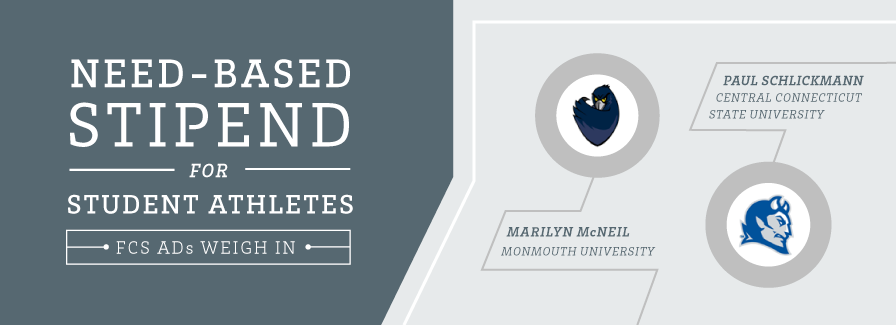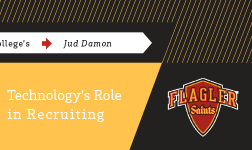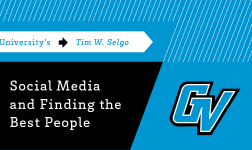
The January announcement from the NCAA regarding a plan to implement a need-based stipend for student athletes received a good deal of scrutiny and attention from media and FBS programs. Tabled for a number of months, the issue arose again in May and, though still being debated, the NCAA is soliciting feedback regarding three possible scenarios:
- Let schools provide up to $2,000 in additional aid without financial need as a requirement.
- Require athletes to demonstrate a need for the stipend by applying through the Free Application for Federal Student Aid (FAFSA).
- Allow schools to use their Student-Athlete Opportunity Funds for the optional stipend.
Winthrop Intelligence was eager to hear from ADs at FCS schools, where there has been less media attention despite the fact that the issue could have a significant impact. Ryan Matthews, Winthrop’s Managing Editor, recently sat down to discuss the issue with Marilyn McNeil — Director of Athletics at Monmouth University — and Paul Schlickmann — Director of Athletics at Central Connecticut State University — to get their thoughts on these possible changes.
What impact will the stipend have on FCS programs in the 12-24 months after implementation?
 Marilyn McNeil – Monmouth University
Marilyn McNeil – Monmouth University
Director of Athletics
I am still very concerned about the impact of this program. I disagree with the concept, and for many of us, finding additional dollars for student-athletes, who do not show actual need, will be difficult. So many of our student-athletes are on small athletics scholarships and are finding a way to get through college. Obviously, many students do not even have the luxury of the athletics scholarship and are making their education happen. Money is tight; the recession is not over, and to ask our donors or our university to give more so that a few can reap the benefits, just rubs me the wrong way. We should be trying to find ways to help all of our students in a more general way.
 Paul Schlickmann – Central Connecticut State University
Paul Schlickmann – Central Connecticut State University
Director of Athletics
The first and most important aspect of this question is that there is a premise or an assumption here that some version of the original legislation proposing a stipend or a Miscellaneous Expense Allowance will still, in fact, be implemented. The evolution of this particular piece of legislation has not moved in that direction. Initially, as part of the Rules Working Group initiative, it appeared to have a ground swell of support. However, as it moved into the legislative cycle and was open to the membership for review and feedback, the FCS membership spoke loud and clear in an override vote against it, from both a philosophical, financial and potential equity standpoint. Even with the development of several possible iterations of the MEA as a result (a straight stipend, a need based model or expanded use of the SAOF, all designed to help student-athletes cover the real cost of attendance) there remains uncertainty about whether it will ever come to fruition. It is my understanding that at their most recent meeting in May, the NCAA Board of Directors has decided to put further discussions regarding the MEA on hold until a) they achieve clarity on the overall NCAA governance structure and b) the Student-Athlete Well Being Working Group further analyzes and clarifies the need (or not) for such a piece of legislation. Thus, the original nature of the question essentially seems moot at this point. But, if you re-frame the question to the current circumstances, I do think the next 12-24 months will now be focused on whether or not such a piece of legislation is necessary, financially feasible across the Division I membership and most importantly, philosophically compatible with the NCAA concept of amateurism. I also happen to think that the result of the pending O’Bannon Case, which could reach finality in the next year or two as well, may influence the real or perceived need for this form of legislation.
What are you doing strategically and on an operational level to prepare for the new landscape created by this stipend? How do you think about additional revenue or cost cutting?
 Marilyn McNeil – Monmouth University
Marilyn McNeil – Monmouth University
Director of Athletics
I certainly hope there will be no cost cutting, but it is not a given that institutions will have to consider that. What a shame to deprive several individuals of an opportunity to participate so that we can fund a select few with a few more dollars. Those select few should consider a loan similar to all of their classmates who do not have the luxury of an athletics scholarship. Although I would like to say we will not participate in this stipend program, the negative recruitment that will begin, may not allow us to make that a good decision.
 Paul Schlickmann – Central Connecticut State University
Paul Schlickmann – Central Connecticut State University
Director of Athletics
Institutionally, we have identified and computed the potential costs associated with each of the three ideas surrounding the original stipend plans. Institutionally, our goal is to fund each of our programs at a level commensurate with our expectations for their competitive success, first and foremost in the Northeast Conference and certainly amongst our peer conferences and in the region as well. Regardless of which option or model is adopted, this will undoubtedly result in increased costs. It is just a matter of the degree of those increased costs. The result is both a practical and philosophical question? How do you maintain your current expectations and program funding commensurate with those expectations while simultaneously adding these potential new costs? It really comes down to three options or a combination thereof, a strategic re-allocations of existing department funds (without negatively impacting existing program budgets), increased institutional allocation to Athletics and increased revenue streams to cover the associated costs.
In lieu of a stipend, how can D-I programs address the need for “full cost of attendance”?
 Marilyn McNeil – Monmouth University
Marilyn McNeil – Monmouth University
Director of Athletics
Students can consider taking out a loan in order to pay for those things they cannot seem to afford with other financial aid and athletics aid. I sent both of my children through university and took out loans to make that happen. Most of the students on a campus are doing the same thing. Why should the athletes be any different?
 Paul Schlickmann – Central Connecticut State University
Paul Schlickmann – Central Connecticut State University
Director of Athletics
I believe there are only two ways to address this issue substantively and practically. One is relatively pragmatic and simple. The other is not.
One approach is to eliminate the limitations on student-athletes concerning the amounts and types of aid that can be received. The NCAA and its member institutions (or perhaps the Student-Athlete Well Being Working Group) need to collaborate to determine the best possible financial aid opportunities for student-athletes. Specifically, it would be prudent to discuss expanding the opportunities and/or eliminate limitations on the types of aid/scholarships that student-athletes can receive (regardless of athletic ability) in order to offset their total cost of attendance. It is not likely that this concept, in and of itself, would satisfy the need or movement for an MEA, but it would be a step in the right direction. The opportunity for student-athletes to accept all aid awarded to them is a key component to their financial and overall well-being.
A second approach is simply to provide student-athletes with more time; the time to get a part time job during the school year in order to supplement their income and defer their expenses. This sounds simpler in theory than in practice. The question of scaling back the time demands on student-athletes would involve a philosophical and substantive overhaul of the existing practice, conditioning and playing seasons in all sports in Division I. It is no secret that the most formidable opponent all our student-athletes face on a daily, semester and annual basis is time management. At this stage in our evolution, I do not foresee a dramatic/strategic rethinking or reformatting of these rules that would allow student-athletes the substantive time they would need to obtain and retain a part time job that would provide them with the financial assistance they might need.
What are your thoughts on the suggestion by some ADs to merge the bottom quartile (in terms of revenue) of FBS and the top quartile of the FCS into a “sub-BCS” subdivision?
 Marilyn McNeil – Monmouth University
Marilyn McNeil – Monmouth University
Director of Athletics
I think the information that we have received about the cost of doing business at the FBS level as opposed to the FCS is very interesting. It should help all of us make good, thoughtful decisions. I don’t think it matters what you end up calling any division. A university should make the right decision for itself. We have gone from college to university division, from small to large divisions, from Division I and Division IAA, and the movement continues to happen. Not sure what can be expected by another division. Now we will have the sub-BCS division compete with FBS and the other FCS schools will consider a move to sub-BCS or BCS. What really has changed in the conversation, other than the labels.
 Paul Schlickmann – Central Connecticut State University
Paul Schlickmann – Central Connecticut State University
Director of Athletics
When you look at some of the financial comparisons of these quartiles, it is admittedly a compelling concept for these two echelons of college athletics to perhaps discuss and come to some common ground. However, as a practical matter, I do not foresee this happening. I know there is widespread speculation that it is only a matter of time before the so called “power conferences” break away and form their own association with their own rules, financial model, etc. To some degree, this has already happened with the widespread conference realignment that has transpired over the course of the last two years. For the following reasons, I think the FBS, FCS and AAA schools will continue to find a way to co-exist in Division I.
- I believe the mutual dependency and the across the board value that all Division I institutions bring to the NCAA Men’s Basketball Tournament will continue to be a binding force amongst the membership.
- I believe that the onset of an NCAA playoff system for the major FBS programs, the continued bowl opportunities for those FBS schools for whom the playoff might not be realistic and the continued committed enhancements to the FCS Championship will satisfy the philosophical and competitive expectations (and demands) of all Division I football playing institutions.
- I also believe the X factor in all this is (or should be) a move by the NCAA Board of Directors to grant equal and across the board access and representation to all Division I conferences as part of a revised governance structure. In my view, this is a critical step toward improving communication and achieving continued common ground amongst a disparate association of schools and programs that comprise our Division I membership.
What might be the least understood aspect about this pending change – what would you suggest that people should know that they may not?
 Marilyn McNeil – Monmouth University
Marilyn McNeil – Monmouth University
Director of Athletics
Well, I really didn’t know that this might become a real option in the near future. I am surprised there is not more dialogue about it. I thought we made an override to change the stipend legislation. However, I know there are certain factions that want this to happen regardless of other opinions. I think we need to do some more education about what is actually going to be implemented and the deadlines associated with it.
 Paul Schlickmann – Central Connecticut State University
Paul Schlickmann – Central Connecticut State University
Director of Athletics
In my view, this is the single most important piece of legislation in our Division I history. It strikes at the very core of the concept of amateurism and our long held stance as an association and as member institutions who grant athletic scholarships. That common philosophical view has been (at least up until now) that the unique educational opportunity afforded to young men and women through an athletic scholarship is not only sufficient, but in a large sense a priceless recompense for their time spent representing their institution in competition, on campus and in the community. I believe, as do many, that this is the tipping point for that aspect of college athletics that has long been considered sacrosanct. If it is inevitable, it is imperative that we vet the nature of, and implementation of, the policy so it is not seen (as it is by many) as purely a reaction to the acuity of the O’Bannon Case and a need, real or perceived, to allay the concerns arising from that issue.




